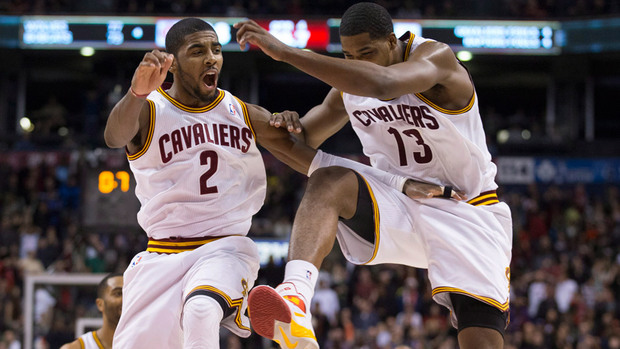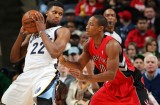Ahh, depth. The gift and the curse.
With the Raptors’ roster in a relative state of stability for the time being, I thought I’d take stock and try to compare how this year’s squad might look in terms of minutes distribution and lineup combinations relative to last year’s.
Of course, the roster I’m assuming here makes some, well, assumptions. The largest of these is that Jose Calderon will remain with the team, which at this point seems like a bit of a long-shot, and we may need to re-adjust this analysis later in the off-season or near February’s trade deadline. Smaller assumptions include the rumored re-signing of Alan Anderson as the 14th man, and the heavily rumored but not yet official signing of point guard John Lucas III to a a multi-year deal (yet another sign the Calderon playing time assumption is a risky one). A final assumption is that the team will continue to roll with Ed Davis and Amir Johnson battling for back-up minutes. While this may be tied to other moves (like a Jose+PF type of trade), the analysis also shows just how difficult it’s going to be for Coach Casey to manage minutes and egos with a squad long on depth but short on guaranteed minutes.
As I said, this is both a gift and a curse. On the one hand, only Bargnani and Lowry are really guaranteed any kind of role. DeRozan will have ample opportunity, as will rookies Ross and Valanciunas, but for the most part the roster has nobody who can expect to be handed 25+ minutes a night without earning it. Casey has a great opportunity to foster competition in training camp and practice while also having a legitimate coaching tool in the option to bench players while adequate back-ups fill in. The fact that when I was constructing possible lineups, I found the “starter” and ‘second unit” players to be almost interchangable shows that the team should be able to handle struggles, injuries, or benchings with relative ease.
As the same time, this can be a problem. There’s something to be said for a short, consistent rotation, and while that might be a luxury afforded to the more top-heavy teams, it will be maddening for Casey and the players to roll too long without defined roles or consistent substitution patterns. DeRozan and Ross, Kleiza and Fields, and Ed and Amir will all be battling for minutes, and in at least one of those cases you would anticipate some bruised ego. Sure, everyone says the right things, and these guys get paid handsomely to accept whatever role comes there way, but Casey will have to be at his best to manage a team that runs 10-deep or more.
Alas, that’s Casey’s problem, and it will give our commenters ample ammunition and discussion fodder for much of the season. So, again, a gift and a curse.
On to some really elemtnary analysis that is more or less me just re-producing charts and passing them off as “work.”
This first chart is simply reproduced from 82games.com and shows the Raptors’ 20 most used lineup combinations from last year, with minutes, +/- (in this case, offensive rating less defensive rating), and eFG% and Rebound Rate all heat-scaled to show effectiveness and usage. The interesting thing here is that our most effective lineup from last year is one of just two combinations that return all five players – the Jose/DeMar/Linas/Amir/Bargs unit was our best one, albeit in a 26 minute sample, and should be identified as a potential unit for this season. The only other really interesting note I can make is that our two most common lineups came in at -0.01 and 0.00 +/- in about 150 minutes each, showing…well, not much, but maybe just that it wasn’t all bad, all the time.
The second chart is more or less the same, as I’ve clipped the top three most common lineups from last year for each of our new acquisitions. I had hoped to show where these players may be able to slide into our existing units with ease (e.g. sliding Lowry in for Jose in our most productive unit, improving it even more perhaps). Unfortunately, the quality and type of players that Lucas and Fields played with are difficult to translate to this Raptors’ squad, in the sense that Fields played with ball-stoppers (but also Tyson Chandler), while Lucas played with maybe the best rebounding and defensive frontcourt in the league. Fortunately for Fields, he should be a party to a more movement-oriented offense that will hopefully see his three point shooting and overall efficiency improve. We can also note that when Fields played SF in a smaller lineup, that particular lineup performed well. For Lowry, who should be our main focus here, he played with players comparable in talent to this Raptors squad. In fact, a Martin-Parsons/Budinger-Scola-Dalembert unit is relatively close (in terms of player-type, not necessarily skill) to a DeRozan-Fields-Bargnani-Valanciunas unit. I should disclaim here that this type of cross-lineup analysis probably isn’t largely indicative of how thigns will translate, so please don’t take these observations to be anything more than that…observations.
This third chart is even simpler than the first two, simply showing a few different looks that Casey could throw out there at times. I used “Type” in the way that NBA 2K/Live do, if you were pre-setting certain lineups, and again, don’t take these as anticipated lineups – they’re just a few potential looks. In fact, if we assume a 10-man rotation with two players at each spot (we’ll bump Amir to the five for this exercise), there are 32 different lineup combinations Casey could roll out, so I won’t pretend to know anything about what he actually plans to roll out there. Still, here are a few potential looks.
This fourth chart is another reproduction of some 82games data, this time showing the percentage of minutes distribution for the Raptors from last year. The “Total Minutes” column comes from just taking a player’s minutes played divided by the total minutes the team played, but for some reason 82games’ individual player pages show position percentages that are slightly higher and add up to 18-24% more than the minutes total for the team. Still, the important trends are still apparent, primarily that a lot of minutes have opened up due to departures, but a lot of expected minutes are coming in as well with three acquisitions and three draft picks.
This final chart shows how I would anticipate seeing the minutes break down this season (not how I personally would break them down). Here we see that if Kyle Lowry is going to be the PG Of Now and Forever, Jose’s role is going to be seriously diminished. We also see that, due to the lack of a top-tier player there’s a big of a logjam at the wing spots, preventing anyone from playing substantial minutes at the expense of others. A final note, as I touched on earlier, I that I just don’t see a way that Ed and Amir can continue to share minutes, especially given the arrival of Jonas and health of Bargnani. Last year Bargs played just 32% of the team’s total minutes, but I’d expect that to be up around 75-80% this year, plus another 40-50% for Jonas depending on where his foul rate ends up. This leaves mere scraps for Ed, Amir, and Gray (less than 48 MPG combined). This might be okay with Aaron Gray, a gritty 10th-man type anyway, but it seems silly to have Davis and Amir split time – it would serve to decrease the trade value of both while leaving less development time for both. With the Amnesty period passed, the team’s only choices are to try and deal one, split the time, or choose one over the other and relegate the loser to spot duty toward the end of the bench.
So…there are some lineup and playing time charts. Do with them what you will.
Olympics start Sunday….between myself and Raul, I’m sure we’ll have some Jonas/Linas coverage (although I said the same thing about Summer League coverage but couldn’t bring myself to watch PVRd exhibition games featuring Ben Uzoh’s Turnover Reel).
—
I never add a byline. I think I’m supposed to. I need more followers…for no reason other than that Arse has about a bajillion. Follow me.









